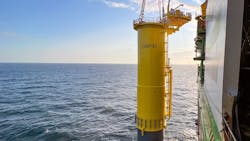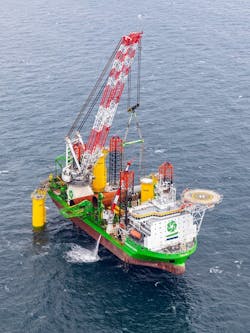First wind turbine foundation works begin at Dogger Bank
Offshore staff
The installation of the first foundations for 277 wind turbines at Dogger Bank Wind Farm in the North Sea has commenced this week, SSE Renewables reported.
The wind farm, which will be located more than 130 km off the Northeast coast of England, will be the largest offshore wind farm and when operational will generate 3.6 GW of energy, which is enough to power 6 million UK homes annually on completion.
The project is making a major contribution to SSE’s plans to invest in excess of £24 billion this decade in Great Britain’s electricity infrastructure system.
Dogger Bank Wind Farm, a joint venture between SSE Renewables (40%), Equinor (40%) and Eni Plenitude (20%), is made up of three offshore wind farm sites in the North Sea. SSE Renewables is lead operator for the development and construction of Dogger Bank Wind Farm, while Equinor will be lead operator of the wind farm on completion for its expected operational life of about 35 years.
The installation of the first monopile and transition piece at Dogger Bank A marks a significant milestone in the project.
Installation of GE Renewable Energy’s Haliade-X turbines onto each of the installed turbine foundations will commence Spring 2023.
Steel manufactured by Tata Steel in Wales and processed in Corby and Hartlepool is being used in the supporting components of the transition pieces, while Metec and Granada Material Handling have won contracts with Smulders to support this project.
The foundations have been optimized to tackle challenging wave loads in the Dogger Bank area of the North Sea, with installation in water depths of up to 32 m and at a distance of 130 km from shore and provide a solid and stable base for the scale of the Haliade-X turbines.
Over the three-year installation program for the three phases of Dogger Bank Wind Farm, a total of 277 monopiles and transition pieces will be loaded onto installation vessels in Rotterdam ahead of transfer out to the offshore wind farm site deep into the North Sea. Using dynamic positioning technology, the vessels will pinpoint the installation site in the seabed at which point a monopile measuring up to 72 m (equivalent to more than six double-decker buses end to end) will be upended and transferred to a pile gripper before being lowered into the seabed.
A hammer will be used to drive the monopile to the design depth in the seabed before a guidance system aligns the installation of the 8-m flanges, which act as a connection for the transition piece that is then installed onto the monopile. The foundations require 152 giant M80 bolts to secure them before a cover is inserted onto the top of the transition piece to leave it watertight.
Seaway 7 was awarded the Tier 1 contract for foundation installation on all three phases of Dogger Bank Wind Farm, with sub-contractor DEME deploying its Innovation vessel for installation of the first foundations on Dogger Bank A. Following the DEME Innovation, the Seaway Strashnov will deploy on Dogger Bank A to continue the foundation installation.
In November 2020, the consortium Sif and Smulders was awarded the contract for the manufacture of all 190 monopiles and transition pieces for the Dogger Bank A and B phases of the wind farm, with a contract for Dogger Bank C’s remaining 87 monopiles and transition pieces awarded to the consortium in 2021.
07.27.2022

